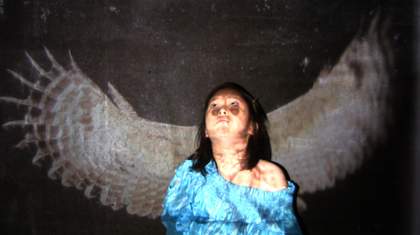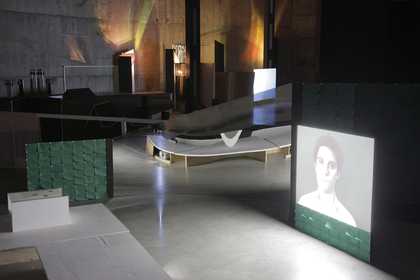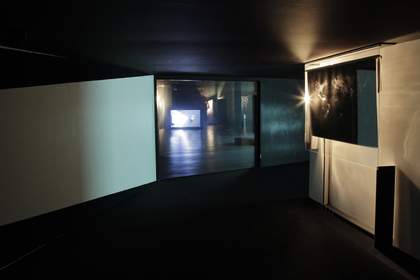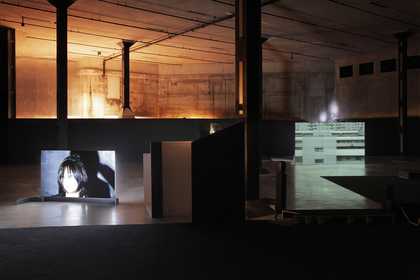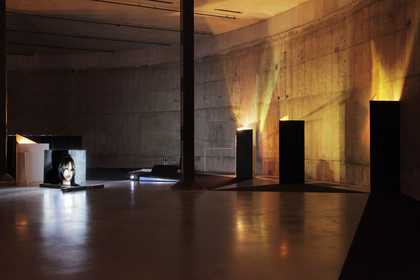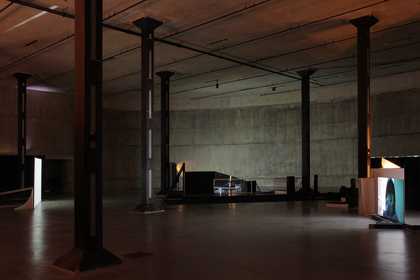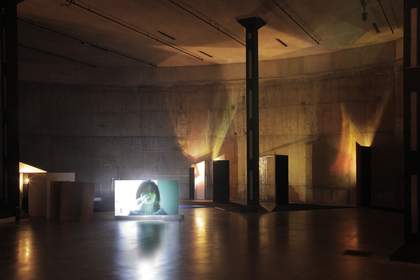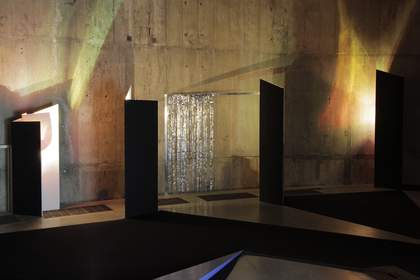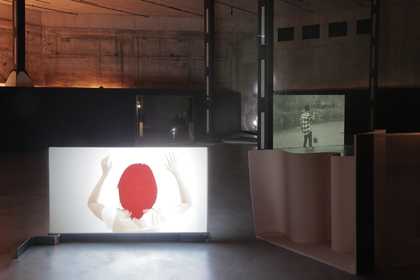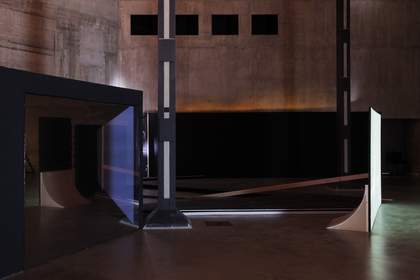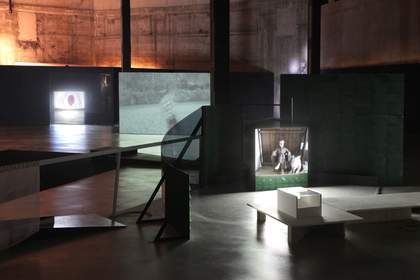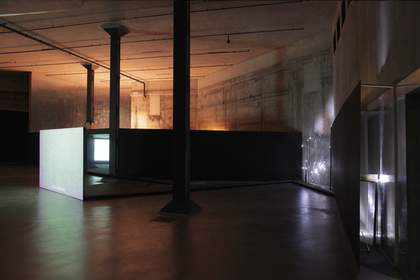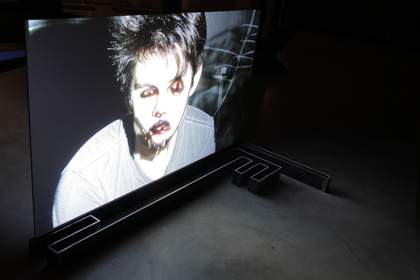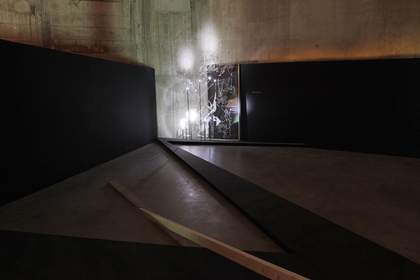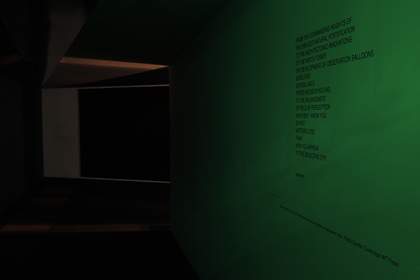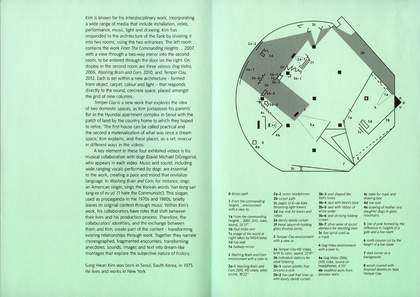Korean artist Sung Hwan Kim’s commission for The Tanks: Art in Action at Tate Modern in 2012 fused four of his video works – one commissioned especially for the Tanks exhibition – with a large architectural installation tailored to the space of the eastern Tank. Kim’s installation created four zones, designated by the use of light, colour, carpeting and objects, for each of the video projections. The four works each demonstrated an aspect of his collaborative relationship with experimental musician dogr (David Michael DiGregorio), who created the soundtrack for, and featured in, the videos. The space of the eastern Tank was split into two rooms, with From the commanding heights… in one space, and the other three installations in the adjoining room. The effect was a journey through Kim’s body of work.
Kim’s video installations all investigated different approaches to space and place, from the artist’s native Korea, to Amsterdam where he studied, and New York where he eventually settled to work, as well as familial, cultural and political histories, and themes of authority and power. Two short video works, Dog Video 2006 and Washing Brain and Corn 2010, both explored these themes through the artist’s biography, and featured representations of members of his family. Dog Video explored Kim’s childhood in South Korea, alongside the home in Amsterdam where he spent his young adulthood. In the video dogr plays a composite character, of a young Kim and Kim’s childhood dog, complete with a canine mask. Kim, meanwhile, portrays his own strict, authoritarian father, also wearing an absurd mask, who shouts contradictory orders at his dog-son to assert control over him. The father figure would frequently ring a ‘pang-eul’, a small Korean bell, which Kim’s real-life father would use to indicate he needed or wanted something. This contrasted with the space of Kim’s home in Amsterdam, where the sounds of distant church bells could also be heard, an authority but at a remove from the home. As with all of Kim’s works on display, the installation featured a musical arrangement, which included a reading of a text by Rainer Maria Rilke and instruments such as the harmonium and kazoo played by dogr. Kim shot the video from a ground-level perspective, creating a sense of voyeurism for the viewer that paralleled the intimate spaces, which were the subject of the film.
While Dog Video explored the rift in the relationship between Kim and his father, Washing Brain and Corn featured his young Korean-American niece. The film drew inspiration from an anti-communist song that featured the line ‘I hate the communists’, which was also in a popular fable from Kim’s childhood about a boy whose mouth was mutilated because he did not pledge allegiance to communism. Washing Brain and Corn juxtaposed Kim’s childhood experience in Korea, with his niece’s in America, exploring the translation of the story across generations and languages. The video also narrated the story of a man who is forced to take on two brains. Through this trope Kim considered the dual identities modern Koreans possess as their culture reference points shift and change.
Concerned with issues of truth and myth, surveillance and power, the most striking feature of the installation for the video From the commanding heights… 2007 – housed in the small room adjacent to the rest of the exhibition – was the inclusion of a two-way mirror. Through this mirror those viewing the video could also watch visitors in the other room, without being detected. As such the power dynamic between being a watcher and being watched, considered in the video, also formed part of the installation. The introductory line to the video stated: ‘I know that it doesn’t matter if things are true or not, but this is a true story’. In this way, it introduced the merging of truth and fantasy in myth and legend.
In the video Kim recited a number of fantastical stories, including one about a woman with a third ear on her head, which he also illustrated by drawing the woman on a transparency. Kim also included a recording of a phone conversation between himself and his mother, in which they discuss an urban legend from his childhood. In this story – which was illustrated by photographs of those involved – Kim and his mother discussed the rumour that during the 1970s, the block of flats that she lived in regularly had power cuts, which the South Korean President Park Chung-hee manufactured in order to be able to visit his mistress. That Kim’s mother was made by the police to renounce the story as false brought to light the issue of rumour within the theme of surveillance. Through the interweaving of the mythical fantasy and his mother’s tale, Kim questioned the nature of the authoritative voice, both by inhabiting that role in telling the audience that they were listening to a true story, and highlighting the use of surveillance and censorship by the South Korean authorities.
The final work featured in the Tanks exhibition was a newly commissioned installation piece, Temper Clay 2012. Featuring a prominent central video projection Temper Clay dominated the East Tank in size and the loudness of dogr’s musical soundtrack. The spaces explored within this video were specifically Kim’s childhood home in the Hyundai Apartments in Seoul and the vacation house where his parents had hoped to retire. The video was narrated by Kim’s nanny, focusing on her labour as a carer in this domestic environment. But it also explored his experience of being a child in the flats and the holiday home, inviting performers to recreate child-like actions including running in, out and around the surrounding woods. This action was overlaid by quotations from Shakespeare’s King Lear on the idea of familial relationships, and the ownership of space and property. For Kim, Temper Clay, was partially an exploration of his family’s connection to the two spaces, but also a reclamation of his forgotten childhood experiences.
Kim’s four video installations, although different in length and content, told the artist’s autobiography from childhood to present day and explored his relationship to family and home. By traversing the gallery space, walking between benches, pillars and other structures, viewers had both a physical and conceptual experience of his life.
Acatia Finbow
June 2016

